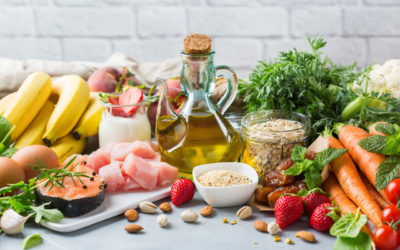Wise choices lower disease risk
Wise food choices, such as low-fat dairy and antioxidant-rich vegetables, may protect you against some of today’s top diet-related women’s health issues.
Women are unique thanks to our complex bodies, composed of a special blend of fat and muscle and regulated by hormonal systems specific to our sex. Though our bodies are masterfully designed to perpetuate the species, we are at risk for gender-related health concerns, many of which have a firm footing in lifestyle choices in particular what we put on our plates.
Eating to avoid osteoporosis
When you go through menopause, you may experience rapid bone loss as your estrogen production drops, which puts you at risk for bone fractures and loss of strength and function. Two lifestyle factors rank equally high in promoting optimal bone health: fitness and food.
“The latest science shows that nutrients like vitamin D and calcium, plus compounds called flavonoids found in green tea, provide bone-building action and
support,” says Victoria Shanta Retelny, R.D., L.D.N., dietitian and author of “The Essential Guide to Healthy Healing Foods.”
Since vitamin D and calcium work together to strengthen bone, getting plenty of both nutrients (600 International Units of vitamin D for women up to age 70, and 1,000 milligrams of calcium for women age 19 to 50 and 1,200 milligrams for those over 50) is essential.
Foods rich in vitamin D and calcium include vitamin-D fortified dairy products, such as milk and yogurt, and fortified plant-based milks like soy, rice and nut milks. Cold-water fatty fish, such as salmon, halibut, tuna and/or mackerel, as well as mushrooms that have been exposed to UV light, contain significant amounts of vitamin D. In addition, your body can manufacture vitamin D through exposure of the skin to sunlight. Calcium sources also include green leafy vegetables, tofu, almonds and soybeans.
Antioxidant-rich foods may protect bones
“Sipping a few cups of green tea daily may give women a bone-building boost from the flavonoid EGCG, which has been shown to mineralize bone,” says Retelny. “Vitamin C-rich foods like strawberries, oranges, pineapples, kiwi, guava and tomatoes help collagen fibers link together and create a strong connective tissue matrix, as well as help protect bones from free radical damage and increase bone mineral density or bone mass.
Physical activity is critical in maintaining bone mass. In particular, weight-bearing activities (at least 30 minutes per day), such as walking, jogging, tennis and dancing; and strengthening activities (twice a week for all major muscle groups), such as pushups and weight lifting, cause your body to work against gravity, thus strengthening bones and muscle and improving balance.
Foods that fight breast cancer
An astonishing 38 percent of breast cancer cases in the U.S. are preventable through healthful living, according to the American Institute for Cancer Research. One of the primary lifestyle factors that can protect you is a healthy body weight.
“Excess body fat sends out chemicals that increase the risk for several types of cancer, including post- menopausal breast cancer,” says Jill Weisenberger, M.S., R.D., C.D.E., dietitian and author of “Diabetes Weight Loss Week by Week.”
Physical activity, which can help you maintain a healthy weight and control hormone levels, offers breast cancer protection, according to Weisenberger, who suggests that you aim for at least 30 minutes per day. In addition, studies have confirmed that alcohol consumption may increase your risk for breast cancer.
“It’s not clear if there is a safe level of consumption, but since modest amounts of alcohol may help reduce the risk of heart disease, women may want to incorporate moderate amounts into their diets one mixed drink, one beer, or one four to five ounce glass of wine per day,” says Weisenberger.
A diet rich in a variety of antioxidant-rich plant foods, from dark green vegetables and citrus fruits to beans and whole grains, also appears to provide nutrients that may suppress cancer development. And if you’re in your childbearing years, breast-feed your infant it’s the best nutrition for your child, and also helps protect you against breast cancer.
A diet to protect your heart
Here’s a sobering fact: Almost every minute in the U.S., a woman dies from heart disease. Once thought a “man’s disease,” heart disease is America’s No. 1 lady killer. Fortunately, diet and exercise are key strategies to protect your heart.
“Your total diet is far more important than any two or three foods you might add or omit from your diet,” says Weisenberger. “Fill your plate with fruits, vegetables, whole grains and legumes. At least two-thirds of your diet should be plant-based, with an emphasis on whole or minimally- processed foods.”
In order to gain the widest variety of nutrients, eat all types of colorful plant foods. As for the best protein choices, choose omega-3 rich seafood at least twice a week, limit fatty and processed meats (bacon, sausage and hot dogs), choose low-fat dairy products, and eat more plant proteins, such as beans, soy and lentils. Focus on healthy plant fats in moderation, like avocados, nuts, seeds and extra virgin olive oil.
This dietary pattern is filled with heart-protective nutrients, including fiber, vitamins, minerals, antioxidants and healthy fats, and is low in all of the heart-damaging nutrients, such as saturated fats, trans fats, sodium and dietary cholesterol. And maintain a healthy weight and physical activity levels–vital elements for optimal heart health.
Managing menopause symptoms with diet
If you’re approaching that pivotal time in a woman’s life–menopause you’re probably anticipating a variety of health concerns, including weight gain and hot flashes. So, what’s a woman to do?
“Hormonal changes are inevitable as women age, but many of the side effects, such as hot flashes and weight gain, can be avoided with a focus on sound nutrition practices and regular physical activity,” says Retelny.
As women’s calorie needs decline during aging, weight gain is common. It becomes even more important to make every bite count by focusing on high-fiber, nutrient-rich foods, such as whole grains, fruits, vegetables and beans.
“Maintaining a high-fiber, plant- based diet, which is low in saturated fat and added sugar, can ensure that your blood sugar levels are stable, fend off cravings and maintain a healthy body weight,” adds Retelny. You can help balance calories in versus calories out by getting plenty of exercise.
Can diet cool down hot flashes? Some studies–but not all–suggest that about two servings of soy foods, such as tofu, soy milk or edamame daily may help ease them.









